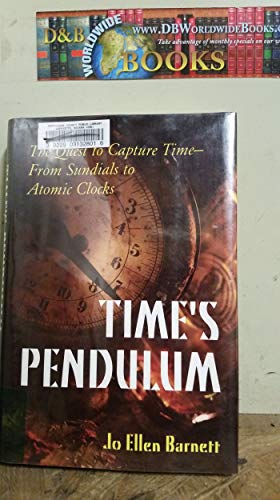Time's Pendulum: The Quest to Capture Time--From Sundials to Atomic Clocks
Barnett, Jo Ellen
About the Book
Description:
New. Seller Inventory # Wizard0306457873
About this title:
Synopsis: Jo Ellen Barnett takes us a step further in our perpetual quest to comprehend time. She bridges the gap between the mechanical clocks which record the fleeting moment as it passes, and the powerful radioactive "clocks" which have opened up to us the eons of the earth's history, by showing that both are based upon the counting of identical time segments. Beginning with a historical look at clocks to tell the time of day, she discusses the impact of such inventions as the church bell, the pendulum, and the wristwatch on human culture, and explains how they've gradually transformed our perception not only of the world, but of time itself.
From Publishers Weekly:
Einstein showed that time is relative on scales barely comprehensible to most of us. In her steadily engaging new book, Barnett, administrator of the Department of Microbiology at the Mount Sinai School of Medicine, shows how our notion of time is relative on a very human level. Time has undergone a long process of standardization over the centuries, she explains. When humankind used sundials, the length of an hour was relative, shorter in the winter and longer in the summer. The Christian church introduced the canonical hours to mark the times for prayers, and various guilds and professions maintained their own time systems. Early mechanical clocks still relied on sundial time because they had to be reset frequently. Thus time was not at all uniform: clocks and bells striking at different times caused such a cacophony in 14th-century Paris that Charles V ordered them all to be synchronized with one at the royal palace. The pendulum clock, with its greatly improved accuracy, put an end to the tyranny of the sun. It also allowed mariners to determine longitude aboard ship for the first time, opening the globe to exploration. The advent of the railroads forced further standardization of time for towns along the tracks, and worldwide time zones put an end to local times once and for all. Now time is measured by the vibrations of the cesium-133 atom to the subatomic degree of precision required by computer-controlled systems. Barnett's book is a triumph of interdisciplinary scholarship that could appeal to a wide variety of readers. 36 illustrations.
Copyright 1998 Reed Business Information, Inc.
Bibliographic Details
Title: Time's Pendulum: The Quest to Capture Time--...
Publisher: Plenum Trade
Publication Date: 1998
Binding: Hardcover
Condition: new
